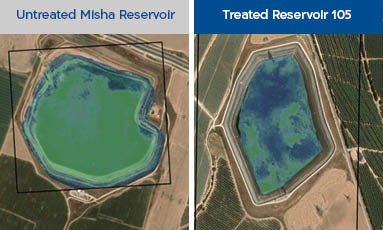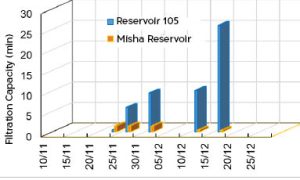Improving Water Quality and Reducing Filter Clogging Using Ozone Nanobubbles in Reservoir 105
A floating ozone nanobubble system was installed in Reservoir 105, operated by the Ashkelon Effluent Users Association, to reduce algae and protozoa populations and enhance the filtration capacity of the treated effluent.
The nearby Misha Reservoir served as a control group.
The results showed a significant improvement in filtration performance and a marked decrease in chlorophyll concentrations, indicating a reduction in algae, demonstrating this innovative treatment’s effectiveness.

Project ID
Location
Reservoir 105, Ashkelon Effluent Users AssociationSystem
Application
Type
Floating ozone nanobubble systemYear
2024Effluent reservoirs often suffer from the proliferation of algae and protozoa, which contribute to biofilm buildup and clogging of filtration systems. This leads to a decline in water quality, disruptions in effluent supply, and the need for frequent backwashing and intensive filter maintenance.
Installation of floating ozone nanobubble systems in Reservoir 105, operated by the Ashkelon Effluent Users Association. A nearby untreated reservoir, Misha, served as a control group. The nanobubble systems effectively reduce algae and protozoa populations, thereby significantly minimizing filter clogging and improving overall water quality.
Water quality was assessed using a filtration performance meter from the Water Workers Union, which measures the time taken to reach a pressure loss of 3 meters in the filtration system. The longer the time, the better the water quality. Additionally, drone-based spectral tests were conducted to measure chlorophyll concentrations in the reservoir (as an indicator of algae levels).
Reservoir 105, equipped with the nanobubble system, showed significant improvements in filtration performance compared to the untreated Misha reservoir. Furthermore, Reservoir 105 demonstrated much lower chlorophyll levels, providing clear evidence of the ozone nanobubble system’s treatment effectiveness.


